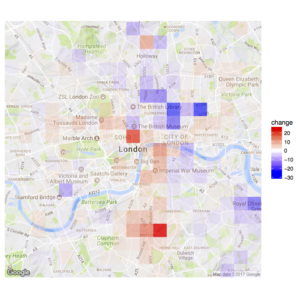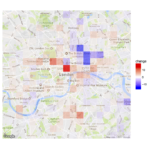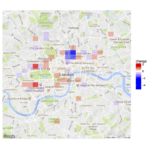Brixton, and from there a corridor towards the Thames ending at Vauxhall and Elephant and Castle are winning. The areas around Islington, Hackney and Greenwich are struggling. The Soho and the rest of Westminster keep doing well. This is at least what starting and failing food-related businesses tell about the last six months in London. I felt food is something everyone buys daily, and whether it is cheap or expensive, less or more, is a good indication of socioeconomic developments.

Increase and decrease of food-related businesses in London over the six month up to October 2017. (Map backgrounds are courtesy of Google Maps. Overlays: R, ggmaps.)
These results were distilled from the food hygiene ratings public database by looking for new and disappearing businesses. How accurate this picture is in a particular area depends to a great extent on how diligently local authorities look after their database. In particular, how quickly new businesses turn up, closed businesses are purged, how accurate the coordinates are, whether changes in ownership or name lead to a new id, and so on. (This, judged by the data, varies throughout the UK.) Differences in the plot may therefore also reflect differences in bookkeeping practices.
Nonetheless, comparing different aspects of the data, there is consistency in what they tell about the development of local population and wealth across London. A major area with new pubs, bars and nightclubs is around Brixton. Restaurants are, as traditional, strong in the Soho and around Hyde Park, and there is some activity in Brixton. Much more popular than restaurants though have been cheaper takeaways and sandwich shops in Brixton and throughout the corridor to the Thames. Restaurant numbers also increased along the south bank of the river from Vauxhall to the City, perhaps due to new, expensive residential developments. However, despite a large number of new residential developments from Vauxhall to Battersea further down the river, this development does not extend to here: the growth in food venues is very modest in this area.
Success further north is mixed. Clerkenwell restaurants are losing, while sandwich shops and takeaways are thriving, especially towards neighbouring King’s Cross. Restaurants struggle even more in Islington and Hackney, and here the cheaper options are not doing well either. This is surprising, as these boroughs have a history of being hotbeds for interesting food ventures.
“Retailers – other” is the category where both the area around Brixton and the corridor are very strong, together with a patch near Marble Arch. Small and artisan retail belong to this category, such as Butter Fingers Bakery, Polish Lake, The Village Rainbow, Hatton Butchers, Forum Cinema and Night & Day Stores; but also Poundstretcher and Boots Pharmacy. Some Sainsbury’s, Marks And Spencer and other chains are also in the list – presumably small markets. Proper big supermarkets do not seem to have taken action in the last six months, as whatever is happening conspicuously avoids this area.
With accommodation the picture is slightly different. There is some activity around Hyde Park. At the same time, the area around King’s Cross is losing.
Altogether the more northerly parts of inner London are a mixed bag of mostly stasis or mild decline except around King’s Cross and Clerkenwell. The central areas around Westminster are keeping up a high standard, with some positive development also in the City. The south, especially formerly more affordable areas are developing briskly, with ventures foremost that are small, affordable, artisan, or fun. This is in line with increasing, but not yet very high income in what looks like a gentrifying area.
![David Molnar [Update:, PhD]](https://www.srcf.ucam.org/~dm516/wp-content/themes/twentyeleven/images/headers/chessboard.jpg)





